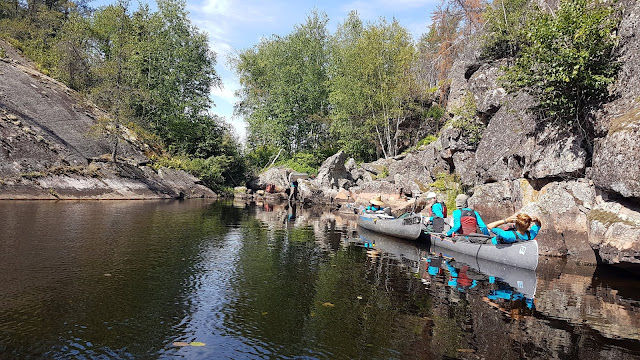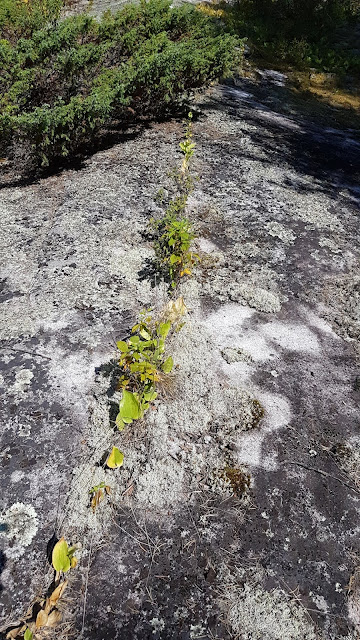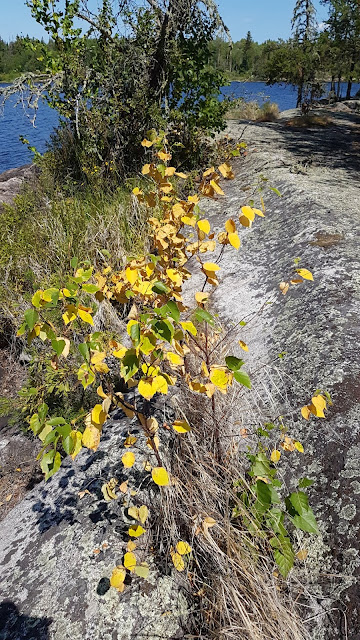Fifty-two years after my last Canadian portage as a canoe guide I'm back under the canoe yoke with a Scout Troop crossing from lake to lake and listening to the mystical calls of the loon and the humming of mosquitoes. I just returned from five days in the wilderness of Atikaki Provincial Park in Manitoba with Davis, California Troop 139. Once a Scouter always a Scout.
I was invited by my brother-in-law David and his son Jack to join them on this Boy Scouts of America Northern Tier High Adventure.
Note: Click on an image to enlarge.
In the early 1960s my father and Scoutmaster of Troop 205 of Long Beach, Mississippi took us on my first wilderness canoe trip from the Sommers Wilderness Canoe Base on Moose Lake near Ely, Minnesota.
I returned in 1964 for a second Sommers expedition in the Quetico-Superior canoe wilderness with my father, my brother Jim, and some of the Camp Tiak summer camp where I worked.
In 1966, I went back to Sommers for “Swamper” guide training and returned in 1967 as a guide for five crews.
In total I experienced nine nine-day wilderness canoe trips covering about 1,000 miles of paddling and portaging across most of this world-famous canoe country.
A few months after leaving Sommers Canoe Base in September 1967 I found myself in the Army, then college, careers, and marriage and I thought my Canadian canoe adventures were far in the past. But in my later years I notice that circles have a way of closing back upon themselves. So I found myself at BSA's Bissett Base in Manitoba, Canada entering the Bay Post and getting gear and food for a paddling trip down memory lane.
Troop 139 formed two crews of about 10 adult advisor-Scouters and Scouts each. I was in "A" Crew led by our "interpreter" guide Dan from Fairfax, Virginia.
Dan patiently guided us through the pre-trip shake-down process to familiarize us with our gear and safety considerations.
Then Dan helped us map out our expedition to optimize our experience in trip length and difficulty.
We chose to see as much new territory without overlap as possible, to fish, to see Ojibway pictographs, and to experience the challenges of difficult and long portages such as "Billy Goat," "Beaver Dam Nation," and the final feather in our voyageur caps: the sphagnum mud slogs of "Heartbreak Portage." What fools we were!
Our adventure began at the canoe cache on Scout Lake (where the orange and red lines join on the map below) and continued counter-clockwise to the second day's paddle in green, the third roundtrip day in blue, the fourth day in purple and the last day in orange.
This blog covers the first three days and is followed by my second blog, Part 2, which covers the last two most difficult days.
We began with a fantastic flight to our canoe cache on Scout Lake on a 1960-built de Havilland Otter lovingly maintained to serve adventurous scouts and more luxury-oriented cabin fishers in the Atikaki Wilderness.
We were dropped off at Scout Lake where Dan selected the best four canoes for our trip from the cache.
Dan instructed us on the portage procedure at our first carry.
We learned the joys of stepping out of the canoe into the water to load ourselves up (and to check our legs for leeches when we get back in the canoe on the other side of the portage.)
We had a steep learning curve to safely handle the heavy and bulky packs and canoes over the rocky terrain of the portages.
Much of this area had been burned by a lightning-caused fire last summer.
On Noname Lake we pondered the mysteries of the centuries-old Ojibway pictographs drawn from their birchbark canoes on the cliff faces.
I suggested that this pictograph shows a shaman celebrating the 1054 CE supernova explosion that formed the Crab Nebula (similar to the pictograph at Chaco Canyon, New Mexico.).
Then we made our first camp at the northern end of Noname Lake where we had the opportunity to taste (and debone) a northern pike compliments of fisherman Bryan.
After a long day of paddling and portaging on our second day (west across Lake David to the "Four Corners") we paddled north to a small island on Lake Kawaseecheewonk which had five fledged merlin falcons noisily calling to each other and swooping overhead. I dubbed this unnamed islet "Five Falcon Island."
We left camp set up here for a second night so we could paddle and portage without packs for a pleasant round trip journey to see the pictographs near huge Sasaginnigak Lake and to glimpse and fish that lake.
The pictographs were sadly vandalized by a few ignorant people. I assume they wanted to be remembered as long as these pictographs but I didn't think kindly of them.
The rest of these photographs are from our relaxing afternoon at the lovely point overlooking Sasaginnigak Lake. We saw 12 white pelicans swimming and taking flight here.
Check out my next blog: Part 2 which completes our Atikaki wilderness canoe adventure.
Note: Click on an image to enlarge.
In the early 1960s my father and Scoutmaster of Troop 205 of Long Beach, Mississippi took us on my first wilderness canoe trip from the Sommers Wilderness Canoe Base on Moose Lake near Ely, Minnesota.
I returned in 1964 for a second Sommers expedition in the Quetico-Superior canoe wilderness with my father, my brother Jim, and some of the Camp Tiak summer camp where I worked.
In 1966, I went back to Sommers for “Swamper” guide training and returned in 1967 as a guide for five crews.
In total I experienced nine nine-day wilderness canoe trips covering about 1,000 miles of paddling and portaging across most of this world-famous canoe country.
A few months after leaving Sommers Canoe Base in September 1967 I found myself in the Army, then college, careers, and marriage and I thought my Canadian canoe adventures were far in the past. But in my later years I notice that circles have a way of closing back upon themselves. So I found myself at BSA's Bissett Base in Manitoba, Canada entering the Bay Post and getting gear and food for a paddling trip down memory lane.
Dan patiently guided us through the pre-trip shake-down process to familiarize us with our gear and safety considerations.
Then Dan helped us map out our expedition to optimize our experience in trip length and difficulty.
We chose to see as much new territory without overlap as possible, to fish, to see Ojibway pictographs, and to experience the challenges of difficult and long portages such as "Billy Goat," "Beaver Dam Nation," and the final feather in our voyageur caps: the sphagnum mud slogs of "Heartbreak Portage." What fools we were!
Our adventure began at the canoe cache on Scout Lake (where the orange and red lines join on the map below) and continued counter-clockwise to the second day's paddle in green, the third roundtrip day in blue, the fourth day in purple and the last day in orange.
This blog covers the first three days and is followed by my second blog, Part 2, which covers the last two most difficult days.
We began with a fantastic flight to our canoe cache on Scout Lake on a 1960-built de Havilland Otter lovingly maintained to serve adventurous scouts and more luxury-oriented cabin fishers in the Atikaki Wilderness.
Dan instructed us on the portage procedure at our first carry.
We learned the joys of stepping out of the canoe into the water to load ourselves up (and to check our legs for leeches when we get back in the canoe on the other side of the portage.)
We had a steep learning curve to safely handle the heavy and bulky packs and canoes over the rocky terrain of the portages.
Much of this area had been burned by a lightning-caused fire last summer.
On Noname Lake we pondered the mysteries of the centuries-old Ojibway pictographs drawn from their birchbark canoes on the cliff faces.
I suggested that this pictograph shows a shaman celebrating the 1054 CE supernova explosion that formed the Crab Nebula (similar to the pictograph at Chaco Canyon, New Mexico.).
Then we made our first camp at the northern end of Noname Lake where we had the opportunity to taste (and debone) a northern pike compliments of fisherman Bryan.
After a long day of paddling and portaging on our second day (west across Lake David to the "Four Corners") we paddled north to a small island on Lake Kawaseecheewonk which had five fledged merlin falcons noisily calling to each other and swooping overhead. I dubbed this unnamed islet "Five Falcon Island."
We left camp set up here for a second night so we could paddle and portage without packs for a pleasant round trip journey to see the pictographs near huge Sasaginnigak Lake and to glimpse and fish that lake.
The pictographs were sadly vandalized by a few ignorant people. I assume they wanted to be remembered as long as these pictographs but I didn't think kindly of them.
The rest of these photographs are from our relaxing afternoon at the lovely point overlooking Sasaginnigak Lake. We saw 12 white pelicans swimming and taking flight here.
Check out my next blog: Part 2 which completes our Atikaki wilderness canoe adventure.



























































